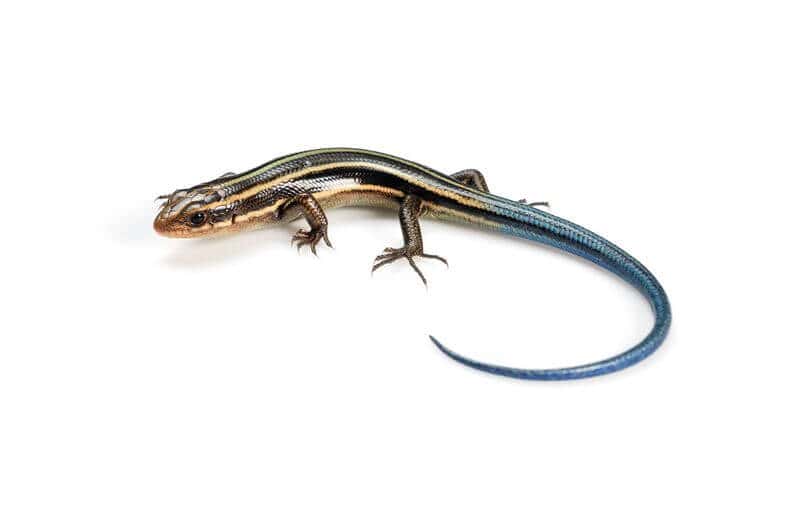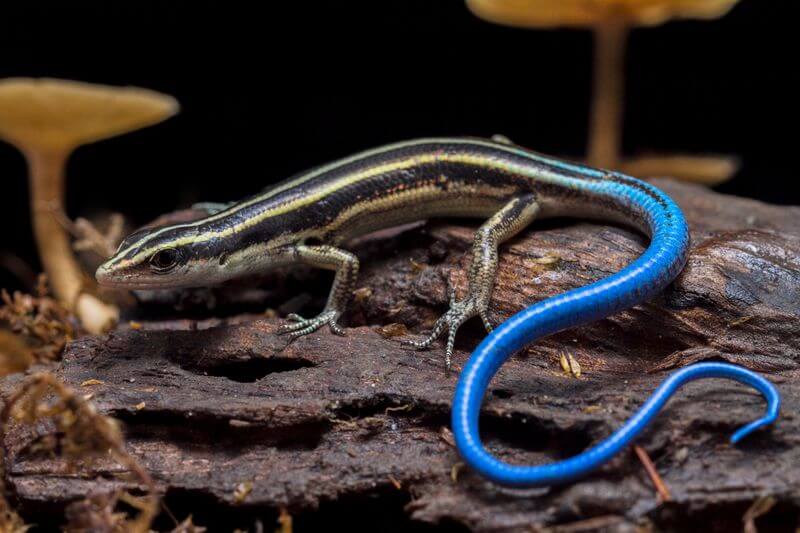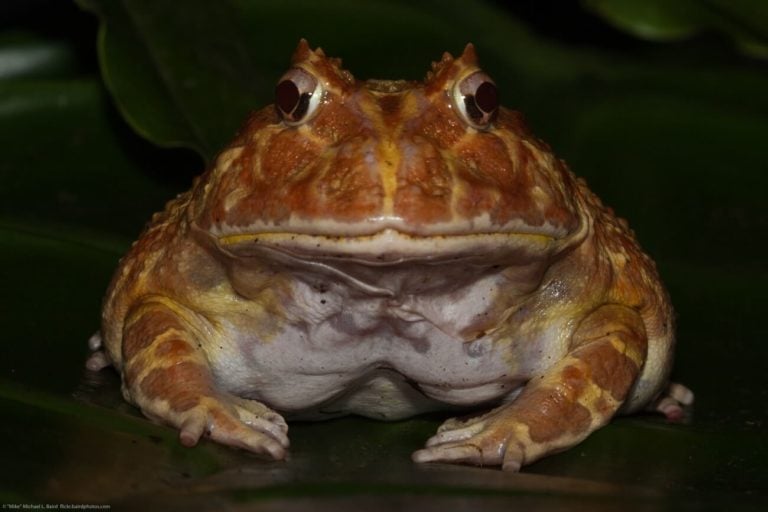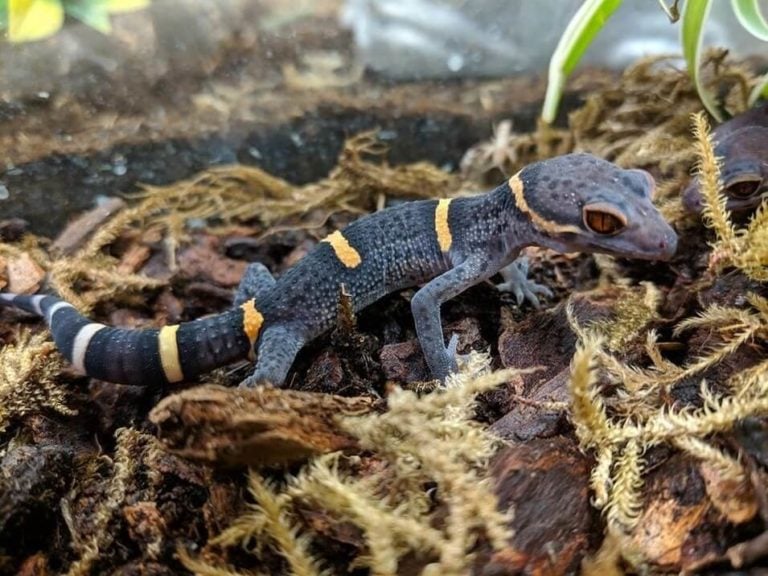Blue-tailed skinks are unique and beautiful lizards that can make great pets. Due to their care requirements and appearance, they’re rather popular in the reptile community!
This guide will go over everything you need to know about blue-tailed skink care. It covers their habitat, diet, size, lifespan, and much more!
Table of Contents
Species Summary
The blue-tailed skink is an eye-catching reptile known for its active nature. The name “blue-tailed skink” doesn’t refer to a specific species. Instead, it’s an umbrella term that describes two distinct species.
The first is the American blue-tailed skink (Plestiodon fasciatus). It comes from the Eastern United States, living in states as far east as Missouri. You can also find the lizards living in some parts of South-Aast Canada.
The second is the Pacific blue-tailed skink. It’s native to the Christmas Islands of Australia but also lives throughout the Pacific Islands.
Both species of blue-tailed skinks make fantastic pet reptiles. Their needs are virtually identical and have the same requirements concerning habitat and feeding. They also look the same, sporting only a few minor differences.
Appearance & Colors
The most identifiable physical trait of the blue-tailed skink is the vibrant blue tail. Blue is rare in the animal kingdom, but these reptiles use the rich hue as a defense mechanism. The skinks use it to attract would-be predators, dropping their tails to escape whenever under attack.
Like other lizard species, the blue-tailed skink can regrow its tail with time.
The rest of the body is more natural-colored. Blue-tailed skinks typically have bodies of dark gray, brown, and black.

While those colors are standard fare in the reptile world, the hues make up a unique pattern on the skink’s body. The dark gray and black colors appear as horizontal lines running from the blue tail to the head or snout.
The stripes stay separate across the entire body on the Pacific blue-tailed skink. Meanwhile, the lines on the American blue-tailed skink merge behind the head. It’s a subtle difference, but it’s what herpetologists use to distinguish the species.
Another key difference is how the blue tail changes. American blue-tailed skinks lose the vibrancy of the tail as they reach sexual maturity (it eventually turns grayish brown).
Beyond the standout coloration, blue-tailed skinks are gorgeous. They have sleek and slender bodies covered in smooth scales. The scales reflect the light, and the fairly uniform shape of the body gives the lizard a snake-like appearance.
Look closely, and you’ll see relatively thin legs with five-digit hands. The blue-tailed skink sports clawed fingers for easy climbing as a semiarboreal species.
The head is smooth and tapered. It’s triangular-shaped, furthering the snake-like appearance.
Expert Tip: Blue-tailed skinks exhibit subtle sexual dimorphism. In both the American and Pacific species, males have wider and longer heads than their female counterparts.
Lifespan
There is no way to guarantee life expectancy in any animal. Blue-tailed skinks are susceptible to health issues and genetic predispositions like any other reptile, and their lifespan also depends on the quality of care you provide.
Typically, the average blue-tailed skink lifespan is six to ten years in captivity. Their lifespans are a bit longer in captivity than in the wild. Wild American blue-tailed skinks usually only live for six years. Pacific blue-tailed skinks live for about seven in the wild.
Average Size
Blue-tailed skinks are on the smaller side of the size spectrum. How big your lizard can get will depend on the specific species you have.
American blue-tailed skinks are the larger of the two, growing to lengths of 8.5 inches in the wild. In captivity, they may remain smaller, depending on the enclosure.
Pacific blue-tailed skinks are slightly smaller, reaching an average size of roughly 6 inches.
Blue Tailed Skink Care
Blue-tailed skink care can be a rewarding experience. Unlike some other popular lizard species, these critters are highly active. They’re a joy to watch throughout the day!
However, you must be vigilant about the lizard’s dietary, housing, and environmental needs to keep them healthy. Here’s what you need to know about owning a blue-tailed skink.
Enclosure Size
Let’s start with one of the most important facets of blue-tailed skink care: The habitat. While Pacific and American blue-tailed skinks live on opposite sides of the world, their enclosure requirements are identical.
The skinks are relatively small, so they don’t need massive habitats. But if you plan to keep more than one together, you’ll need to consider the individual space needs of every lizard.
For a single blue-tailed skink, you can use a 20-gallon glass terrarium. That’s the bare minimum for a single skink. For a multi-lizard setup, add at least another 10 gallons of volume for each additional skink. If possible, go for an extra 20 gallons per skink.
If you want to keep a mix of one male and three females, the best scenario would be an 80-gallon tank.
Blue-tailed skinks are semiarboreal. As a result, you should focus on height. Enclosures need at least 18 inches of height to accommodate the lizard’s penchant for climbing.
For length and width, go for enclosures about 48 inches long and at least 24 inches wide for a multi-skink setup.
When choosing a tank, always select one with a tight-fitted lid for security.
What To Put In Their Habitat
The best way to keep your blue-tailed skinks happy and healthy is to mimic their natural habitat. These lizards live in forests littered with natural debris. You can usually find them among leaves or on fallen logs in the wild.
To recreate that environment, use a natural substrate material that can hold onto moisture. The best choices are orchid bark, humus, and coconut coir. Avoid using pure sand or substrates with rocks the lizard could accidentally swallow.
Use the substrate to create a thick layer of about four inches at the bottom of the enclosure. Blue-tailed skinks like to burrow when not climbing, so a four-inch wide foundation is enough to accommodate that behavior.
Next, add lush plants. You can use artificial plants for easier maintenance, but live plants can help maintain environmental conditions. Use plants that provide coverage and facilitate climbing, such as ferns, devil’s ivy, etc.
You can also add rocks, fallen rocks, and other natural items the lizard would find in the wild. The goal with your decor is to give your skinks plenty of opportunities to hide and explore.
Climbable surfaces are another important addition. Use rocks, bark pieces, and vines to create a network of climbable surfaces for your skinks to explore.
Temperature & Lighting
Blue-tailed skinks are diurnal lizards. Therefore, they need a standard day and night cycle with about 10 to 12 hours of light daily. Creating the lighting rig will require a few different pieces of equipment, depending on your setup.
The most important thing is a heating lamp. Position the lamp on one side of the tank to create a temperature gradient and basking spot. You can achieve the same effect with multiple lights, but using a single heating lamp that covers the enclosure is the easiest method.
Temperature preferences are where American and Pacific blue-tailed skinks differ slightly.
American blue-tailed skinks like the temperature gradient to be between 72 and 82 degrees Fahrenheit. For the basking spot, they prefer temperatures up to 110 degrees.
Pacific blue-tailed skinks prefer a temperature gradient between 77 and 82 degrees Fahrenheit with a basking spot of up to 95 degrees.
Because those temperatures differ, mixing Pacific and American blue-tailed skinks in one enclosure is not a good idea.
In addition to the heating lamps, you’ll need some other equipment to support the tank and your skinks. If you have live plants, installing LED growth lamps is a good idea. They’ll keep your plants healthy.
Blue-tailed skinks also need UVB exposure. UVB light gives the skinks the Vitamin D they need to metabolize calcium. Without it, your skinks can suffer from painful health issues. More on that later.
Install a UVB light above the enclosure, ensuring the light covers the entire habitat. Put all your lights on a timer, and remember to change the UVB light bulb every six months.
Humidity
Humidity is another important environmental factor to stay on top of. Blue-tailed skinks need the relative humidity levels in their enclosure to remain within 60 and 80 percent.
The best way to keep humidity levels high is to mist the substrate. Misting keeps things nice and muggy while also benefiting live plants.
You can also install an automatic mister or reptile fogging humidifier.
It’s always a good idea to invest in a high-quality digital hygrometer. You need to monitor humidity levels regularly to avoid health complications. Whenever levels get too low, mist the tank. Open the enclosure’s ventilation to promote airflow when they get too high.
Ideally, you should maintain stable humidity levels throughout the day. Avoiding major humidity swings will prevent stress on your pet.
Water
Like other reptiles, blue-tailed skinks rarely lap up water like a mammal. Instead, they absorb moisture through their skin and occasionally lick dew droplets off plants.
Even still, it’s wise to install a water bowl in their habitat. Blue-tailed skinks use the water dish to soak. Some may defecate in the bowl. Whatever the case, the water helps maintain humidity levels and gives your lizards another way to stay hydrated.
Use fresh, dechlorinated water. Many herpetologist buffs use distilled water. However, you can also use reptile-safe water conditioners.
Clean the water bowl regularly to address messes and replenish the water daily.
Blue Tailed Skink Food & Diet
In the wild, blue-tailed skinks have a diet that consists of a variety of foods. They’re mostly carnivorous, feeding on insects, worms, and snails.
Captive blue-tailed skinks thrive on a diet that consists of 90 percent protein. They can eat the occasional fruit, but you should focus on insects instead.
Some of the best foods for blue-tailed skinks include:
- Dubia roaches
- Crickets
- Mealworms
- Waxworms
- Earthworms
- Fruit flies
Larger blue-tailed skinks can also eat pinky mice or spiders.
When you provide insects, make sure they’re gut-loaded. Only get your insects from reputable sources and avoid feeding them anything you catch outside. It’s also important that you dust them with calcium and multivitamin powders.
Expert Tip: The best way to feed blue-tailed skinks is to provide enough food that they can eat in five minutes. After the five-minute mark, remove any leftover insects to keep bacteria and filth at bay.
Potential Health Issues
For the most part, blue-tailed skinks are hardy reptiles. However, they’re not completely immune to health problems.
The biggest concern for these lizards is metabolic bone disease. This condition occurs when the skinks can’t metabolize calcium. Their bones become weak and brittle, making them prone to fractures, deformities, and other painful issues.
The best way to avoid metabolic bone disease is to dust all insects in calcium powder and install a UVB lamp. Those are crucial care requirements you need to manage.
Blue-tailed skinks are also prone to parasitic and bacterial infections. Parasites usually occur when introducing a wild lizard or insect into the habitat. Always stick with captive-bred skinks and gut-loaded insects from a trusted source.
Bacterial infections can arise whenever a skink experiences injury. These lizards can bite one another if they live in cramped quarters. Males tend to get aggressive.
The best way to avoid conflict is to house multiple skinks in a large tank and keep all females or one male to three females to maintain peace.
Behavior & Temperament
Blue-tailed skinks are active and curious. Throughout the day, your lizards can explore every inch of the enclosure. They may bask on a tall branch before heading to the substrate to dig and burrow!
Captive-bred skinks are usually docile. They’re relatively easy-going compared to wild-caught skinks.
However, conflicts can arise when not pairing multiple skinks the right way. Males get territorial and aggressive, so you must plan the habitat accordingly to keep numerous skinks. Avoid keeping more than one male in the same enclosure.
Instead, consider getting all females or outnumbering the females. Female blue-tailed skinks are much more docile and don’t resort to aggressive behaviors.
Handling
Despite their docile nature, blue-tailed skinks don’t tolerate handling. You can handle them briefly to move them from the enclosure during deep cleaning, but you shouldn’t handle them for fun. The best way to appreciate these lizards is through observation instead of physical handling.
As mentioned earlier, blue-tailed skinks will drop their tails when threatened. Handling the lizard increases the risk of that happening. They get too stressed when handled, and many will drop their tails to let you know.
Conclusion
Blue-tailed skink care isn’t anything to be afraid of. In fact, these reptiles can be downright easy to own if you’re well-prepared!
We hope you found this guide helpful and are excited to start your journey of ownership. If you ever have any questions, feel free to ask.



